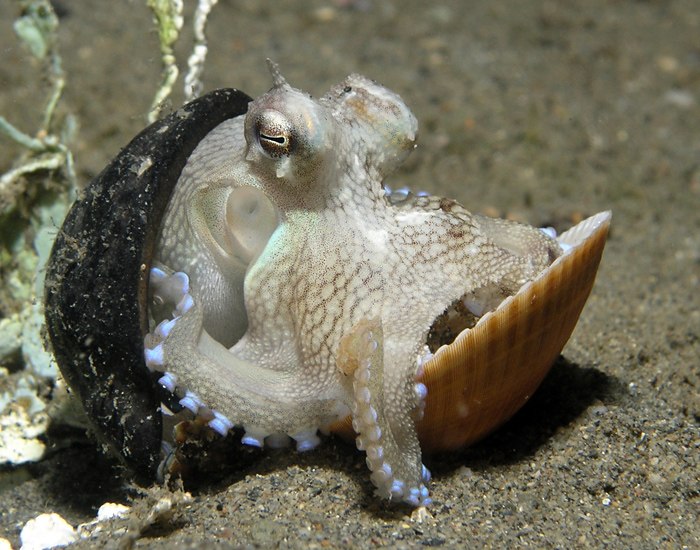
Issue 16 September 2008
Off-Gassing...
(Web Version)
Welcome to the September issue of our newsletter.
Congratulations to everyone who joined in with the Submergathon—we made the Chase Post and regional variations.
We hope everyone had a great summer, despite the weather.
Chronicles of the Bad Tamel

This section of the newsletter has been dedicated to the Chronicles of Bad Tamel, so called by the D.O as he once led a party of divers away from the sea and into a beer festival. This however might have been quite innocent, as it could possibly have been the result of a compass reading! While we’re on the subject, the club’s newly appointed minstrel has started to record past atrocities and indiscretions by said Tamel. He has written a series of verses which fit nicely to the tune of Black Adder. Here’s one to jog your memories:
![]()
Bad Tamel dived the Menai Straits,
And though he did this most discretely,
He came up in the North of Wales,
Thus missing Angelsey completely.
Bad Tamel, Bad Tamel,
He led us through the years.
Bad Tamel, Bad Tamel,
Had far too many beers.
Bad Tamel, Bad Tamel
This navigation ace.
Bad Tamel, Bad Tamel
This waste of bleedin’ space!
More Bad Tamel adventures to come, with the trip to Scotland, and more songs from the minstrel.
The Prima search for new dive sites
If you have any items for sale please let us know.
First stop, Leh, Ladakh.
About Ladakh India
A land of freezing winds and burning hot sunlight, Ladakh is a cold
desert lying in the rain shadow of the Great Himalayas and other smaller
ranges. Little rain and snow reaches this dry area, where natural forces
have created a fantastic landscape. Surrounded by rugged mountains this
land is completely different from the green landscape of many parts of
the Himalayas. Bounded by two of the world's mightiest mountain ranges,
the Great Himalaya and the Karokaram, it is a land which has no match.

In geological terms, this is a young land, formed only a few million
years ago by the buckling and folding of the earth's crust as the Indian
sub-continent pushed with irresistible force against the immovable mass
of Asia. Its basic contours, uplifted by these unimaginable tectonic
movements, have been modified over the millennia by the opposite process
of erosion, sculpted into the form we see today by wind and water.
The main source of water in this land remains the winter snowfall.
Ladakh was once covered by an extensive lake system, the vestiges of
which still exist on its south -east plateaux of Rupshu and Chushul - in
drainage basins with evocative names like Tso-moriri, Tsokar,and
grandest of all, Pangong-tso. The temperature rarely exceeds 27 degree
celcuis in summer while in winter it may drop to minus 20 degree celcuis.
Dive site rating: ZERO ..... On we go.......................
Watch this space for news from our overseas correspondents—adventures in India and Thailand. Follow the trail of destruction as Sue and Richard cause havoc in the Asian continent!
Sea Creature of the Month
Editors Corner
Thank you to everyone who has contributed to this months issue, and
apologies for any mistakes.
Any further articles for next months edition would be appreciated, (any gossip, scandals, etc that’s printable) so let us know by 28th September 2008.
If anyone would like to write a profile of their diving career, please let us know.
Hope you enjoyed this issue.
Thought for the month
" Never say you know a man until you have divided an inheritance with him. "
The octopus (from Greek 'eight-footed') with plural forms: octopuses, octopi, or octopodes,
Octopuses are characterized by their eight limbs. It was originally conceived that all eight of the limbs were arms but recent studies have shown that octopuses have six arms and two legs (as distinct from the tentacles found in squid and cuttlefish), usually bearing suction cups. These arms are a type of muscular hydrostat. Unlike most other cephalopods, the majority of octopuses — those in the suborder most commonly known, Incirrina — have almost entirely soft bodies with no internal skeleton. They have neither a protective outer shell like the nautilus, nor any vestige of an internal shell or bones, like cuttlefish or squid. A beak, similar in shape to a parrot's beak, is the only hard part of their body. This enables them to squeeze through very narrow slits between underwater rocks, which is very helpful when they are fleeing from morays or other predatory fish. The octopuses in the less familiar Cirrina suborder have two fins and an internal shell, generally reducing their ability to squeeze into small spaces.
Octopuses have three hearts. Two pump blood through each of the two gills, while the third pumps blood through the body. Octopus blood contains the copper-rich protein hemocyanin for transporting oxygen. Although less efficient under normal conditions than the iron-rich hemoglobin of vertebrates, in cold conditions with low oxygen pressure, hemocyanin oxygen transportation is more efficient than hemoglobin oxygen transportation. The hemocyanin is dissolved in the plasma instead of being bound in red blood cells and gives the blood a blue color. Octopuses draw water into their mantle cavity where it passes through its gills. As mollusks, octopuses have gills that are finely divided and vascularized outgrowths of either the outer or the inner body surface.
Octopuses are highly intelligent, probably more intelligent than any other order of invertebrates. The exact extent of their intelligence and learning capability is much debated among biologists, but maze and problem-solving experiments have shown that they do have both short- and long-term memory. Their short lifespans limit the amount they can ultimately learn. There has been much speculation to the effect that almost all octopus behaviors are independently learned rather than instinct-based, although this remains largely unproven. They learn almost no behaviors from their parents, with whom young octopuses have very little contact.
An octopus has a highly complex nervous system, only part of which is localized in its brain. Two-thirds of an octopus's neurons are found in the nerve cords of its arms, which have a remarkable amount of autonomy. Octopus arms show a wide variety of complex reflex actions arising on at least three different levels of the nervous system. Some octopuses, such as the Mimic Octopus, will move their arms in ways that emulate the movements of other sea creatures.
In laboratory experiments, octopuses can be readily trained to distinguish between different shapes and patterns. They have been reported to practice observational learning, although the validity of these findings is widely contested on a number of grounds. Octopuses have also been observed in what some have described as play: repeatedly releasing bottles or toys into a circular current in their aquariums and then catching them. Octopuses often break out of their aquariums and sometimes into others in search of food. They have even boarded fishing boats and opened holds to eat crabs.

Defence
Three defensive mechanisms are typical of octopuses: ink sacs, camouflage, and autotomising limbs.
This small octopus species will travel with shells that it has collected for protection.
Most octopuses can eject a thick blackish ink in a large cloud to aid in escaping from predators. The main colouring agent of the ink is melanin, which is the same chemical that gives humans their hair and skin colour. This ink cloud dulls smell, which is particularly useful for evading predators that are dependent on smell for hunting, such as sharks.
An octopus's camouflage is aided by certain specialized skin cells which can change the apparent color, opacity, and reflectiveness of the epidermis. Chromatophores contain yellow, orange, red, brown, or black pigments; most species have three of these colors, while some have two or four. Other color-changing cells are reflective iridophores, and leucophores (white). This color-changing ability can also be used to communicate with or warn other octopuses. The very venomous blue-ringed octopus becomes bright yellow with blue rings when it is provoked.
When under attack, some octopuses can detach their own limbs, in a similar manner to the way skinks and other lizards detach their tails. The crawling arm serves as a distraction to would-be predators; this ability is also used in mating. A few species, such as the Mimic Octopus, have a fourth defense mechanism. They can combine their highly flexible bodies with their color changing ability to accurately mimic other, more dangerous animals such as lionfish, sea snakes and eels.